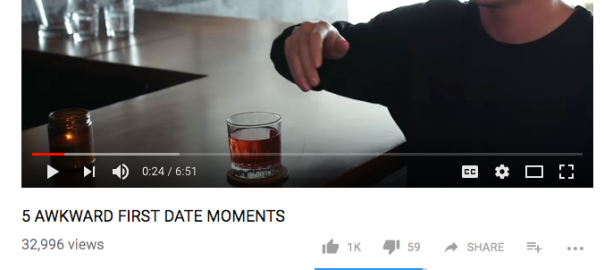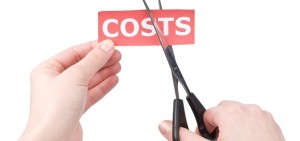— March 30, 2018
The Marketer’s Guide to Finding and Selecting the Best Influencers for Your E-commerce Brand:
With 67% of marketers increasing their influencer marketing budgets this year, it’s safe to say this “new” marketing strategy is reaching its heyday. Everyone knows the powerful return on investment you can get when you work with influencers to promote your brand. Influencers are only becoming easier to find thanks to marketplaces and search tools, but that doesn’t make finding the right influencers any less of a challenge. If you want your influencer marketing campaign to bring an impressive ROI (like you know it can), you need to recruit influencers with the creative skills and audience makeup that matches your brand message.
Here are 7 simple steps you can take to ensure your influencers have what it takes to help drive your marketing goals.
Step 1: Define your goals
No matter what marketing task you’re up to, goals always need to be the first step.
If you’re new to influencer marketing and not sure what you can achieve with it, Mavrck created a nice infographic of the most popular influencer marketing objectives brands use.
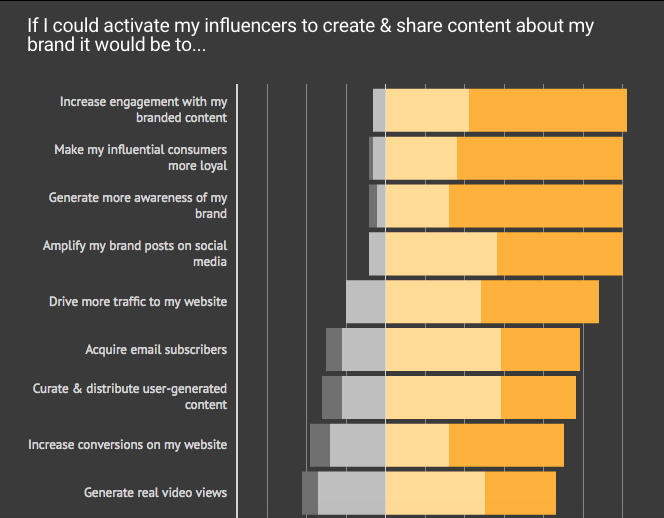
Your goals will help you figure out what kind of influencer content you’ll need to create, which platforms you want your influencers to publish it on, and what kind of influencers are the best for your brand.
Say your goal is to make your influential consumers more loyal (a popular brand objective). In this case, finding the right influencers is easy. Engage in social listening and track your brand mentions across the web. Identify influential people who are already talking about your business or products, and then you can recruit these influencers to do so in an official capacity.
Step 2: Pick your platform(s)
Valuable influencers exist on many platforms around the web – not just Instagram and YouTube. And many businesses are just starting to take advantage of these options.
For example, big brands like L’Oreal and Marriott started working with Snapchat influencers to help connect with the platform’s younger audience.
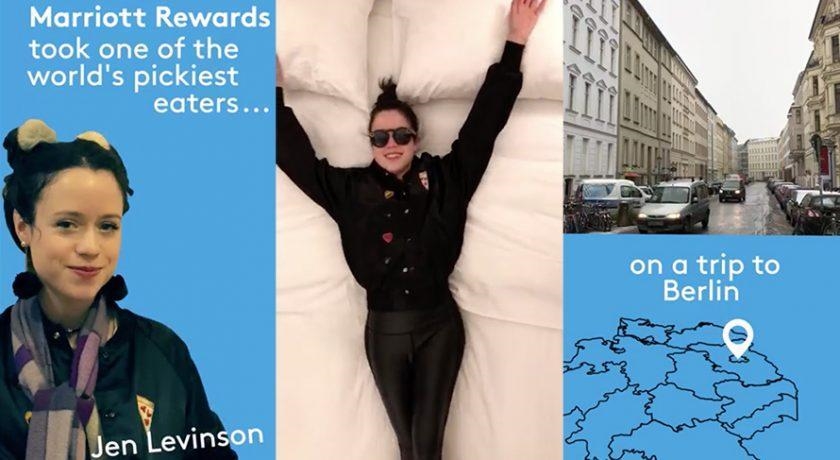
So before you start looking for influencers, you need to figure out which platforms your target audience engages on most:
| Social media platforms | Video platforms | Websites |
| Instagram, Twitter, LinkedIn, Facebook, Google+, Pinterest, Snapchat, Tumblr, etc. | YouTube, Periscope (also Facebook, Instagram, Snapchat, Twitter and Tumblr) | Bloggers, popular niche forum users |
The platform you pick will depend on:
- Where you want to reach your audience
- What kind of influencer content you want to create
Say you want to make a 5-minute branded video with your influencer. You’ll want to consider all video platforms, and even think about a livestream video campaign. If you want a blogger to review your product, you might also consider having them write a blog post and share the post on their social media profiles.
Once you know what platforms you want your influencer content to appear on, you can narrow down your search for influencers immensely.
Step 3: Micro or macro?
Next you need to decide how “big” of an influencer you want to find. Say your brand sells natural skin care products. Do you want to team up with Organic Beauty Talk, one of the biggest bloggers in the niche, or find a team of a few micro-influencers all with around 5,000 followers on Instagram?
Don’t underestimate the power of working with micro-influencers in this case. Micro-influencers tend to have a highly-engaged niche audience that values the influencer’s recommendations as a peer. If you work with micro-influencers, all you’ll need to do is build a team of them in order to scale your campaign.
What kind of influencer you want to work with might depend on your brand goals. If you’re promoting a sale or a new product, micro-influencers are very valuable. If you want to boost brand identity by investing money and resources in creating a sponsored video, then it’s smart to target larger-scale influencers like popular YouTubers or Facebook Live celebrities.
Step 4: Narrow down by niche
Celebrity endorsements were a precursor to what we know as influencer marketing today. Get nearly any celebrity to say they like your products and you’re bound to see an increase in sales. Shaq endorsing a sugar substitute product is an example of this. Martha Stewart recommending a certain crockpot is a little more niche-specific.
Let’s go back to the organic makeup brand example. They wouldn’t want to look for Instagram users who simply offer makeup tips to their audience. They need to find influencers who actually have a genuine interest in and use organic makeup products. The more relevant an influencer is to your brand’s niche, the more likely it is that their audience will respond to their recommendations. So unless a generalist has some other ability that makes them valuable to your influencer marketing campaign, look past them to find the best niche influencers for your brand.
Buzzsumo can help you find niche influencers by keyword. Click “Influencers” from the main Buzzsumo tab then type in a specific keyword (e.g. “chic fashion” instead of just “fashion”). It will return a list of influencers who have the keyword in their bio.
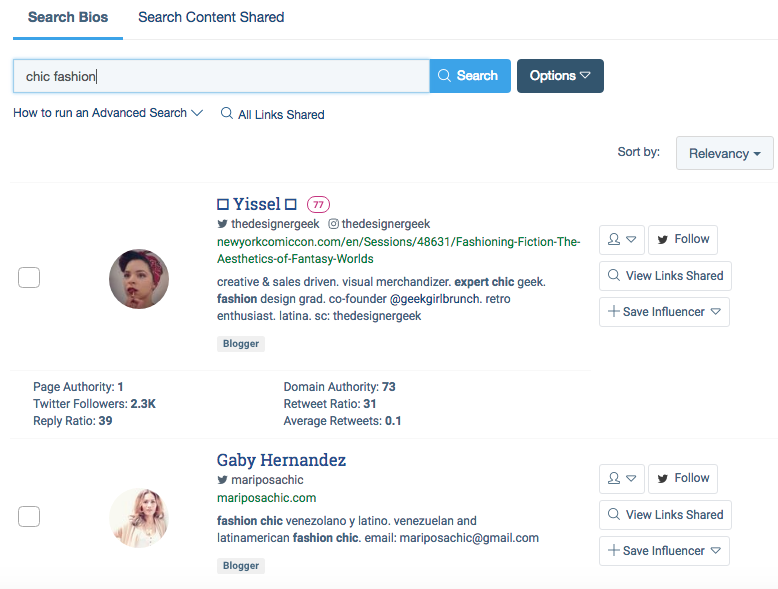
It also includes helpful vetting information such as domain authority, number of Twitter followers, and engagement metrics. If you have a paid Buzzsumo account, then you can also click the ‘Search Content Shared’ tab and find influencers who used your target keyword in their content, not just their bios.
Step 5: Evaluate engagement
Once you’ve found a few macro- or micro-influencers relevant to your business niche, take some time to look at how effective they are at engaging their audience. Take a scroll through their most recent posts:
- Do they get a lot of likes/shares?
- Do they get a lot of comments?
- What is the sentiment of those comments?
- Does the influencer encourage engagement by responding to comments?
- If you’re working with a blogger or YouTuber, does their content get a lot of shares on other social sites?
If you’re using an influencer marketing platform to find leads, they may have some engagement metrics available to help you evaluate potential influencers. A good platform is one that uses engagement data sorted by platform to suggest how much brands should compensate an influencer for their services.
If you’re having trouble finding influencers with good engagement in the first place, you can use Buzzsumo (mentioned above), or TweetDeck.
On TweetDeck, you can search for tweets based on keywords or hashtags, and set parameters to narrow down your search, such as a minimum number of retweets, likes and replies. That will help you find influencers who are already doing well with engagement.
Step 6: Brainstorm content together
Once you think you’ve found the right influencer to work with, ask them to work together to brainstorm and create content around your brand. Many influencer marketing platforms include this strategy in their collaboration process — on Famebit, for example, YouTube influencers pitch brands video ideas before they agree to work together. That’s how businesses are able to pick the right influencers with a unique creative eye for their brand’s message. Famebit collaborations like Canon’s branded video with TribeTyler or Office Depot’s school supply video with Ella Elbells are great examples of this strategy in action.
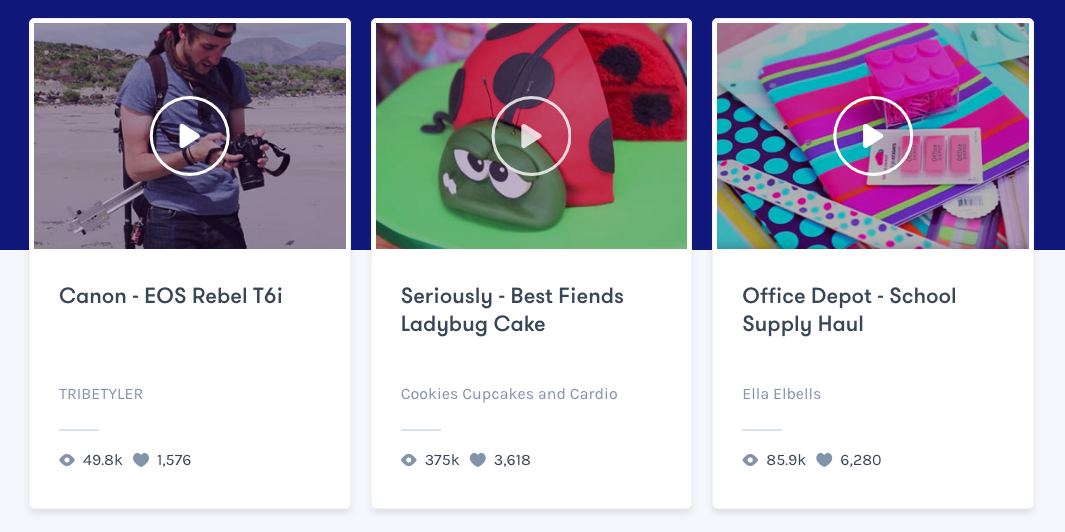
Giving your influencers some creative freedom in this respect is a great way to evaluate whether they’re really a good fit to work with your brand. If an influencer can’t come up with a genuine positive comment about your product/brand, then they’re probably not a good person to work with in the first place.
Step 7: Take a few influencers for a test run
If you followed steps 1-6, you’ve already gone a long way to ensure your influencers can effectively help promote your brand and meet your marketing goals. You should have enough confidence to put them through one last test — create and share your influencer content, and then monitor the results.
Even if an influencer has an engaged audience, you won’t know how that audience will respond to your branded message specifically until you try it on them. Keep track of the performance of your individual influencers so you can evaluate which is the most effective at driving your marketing goals. For example:
| Goal | Potential Metrics to Follow |
| Brand awareness | Brand mentions on social media and across the web, views of influencer videos on YouTube, etc. |
| Brand engagement | Likes, comments and shares of influencer content |
| Sales | Revenue generated from influencer coupon codes, trackable links |
| Grow your social following | Number of new followers gained during influencer campaign |
| Increase site traffic | Referral traffic from influencer links |
Trackable custom links are probably one of the most valuable tools a brand can use to evaluate individual influencer performance. Here’s an example of how Head and Shoulders used trackable links in their influencer YouTube video with Rhodes Bros:
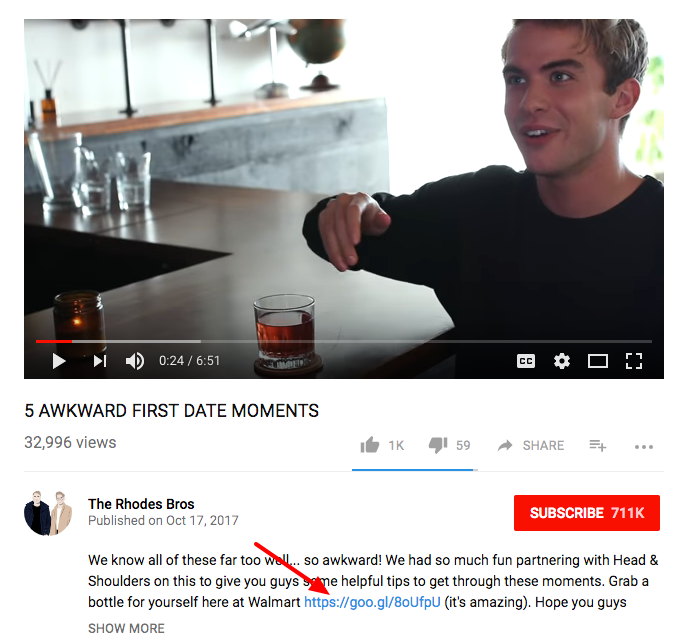
Do this repeatedly with each new influencer you find, and you’ll be able to build a team of powerful brand advocates to broaden reach, help you find new leads, drive sales, encourage retention, and more.
Wrapping up
If you want to work with influencers who can really help drive your brand marketing goals, you need to do more than just search Instagram for people to post about your products. Real, unsolicited recommendations online are well thought out, genuine comments from people who are actually interested in your niche products. They also have the creative skills to create a message that their audience listens to, remembers, and refers back to when making purchase decisions later on.
Remember these 7 steps when you conduct influencer research, and you’ll be well on your way to finding the best influencers for your brand’s needs.
Digital & Social Articles on Business 2 Community
(80)
Report Post